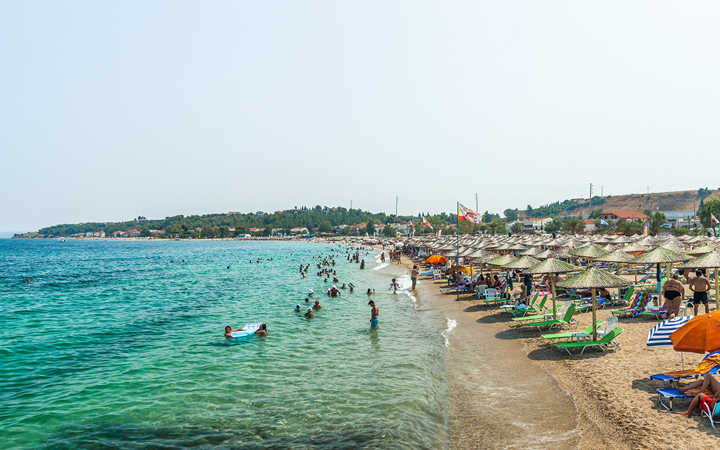Strategically located at the narrowest, northernmost point of Kassandra peninsula, Nea Potidea (pop. 1,500) is about 70km southeast of Thessaloniki. At this point Kassandra is just a neck of land 1,200 meters wide. A 45 meter-wide canal was dug across this neck of land, connecting Toroneaos Bay with the Gulf of Thermi, saving boats narrow enough to make the passage the more than 100-kilometer trip circumnavigating Kassandra. The canal has effectively turned Kassandra into an island. Its existence is first mentioned in writing by the ancient historian Strabo in the first century, AD, although it is several centuries older than even that ancient date.
History
Seafaring ancient Corinthians, in the 7th century, BC, seeking a place to found a colony, picked Nea Potidea's site, recognizing its critical location in controlling traffic on the Gulf of Thermi, Toroneaos Bay, and the land route down into Kassandra. Its patron was Poseidon, god of the sea, hence the name "Potidaea." The colony sent ships to help defend Athens from the Persians in the famous naval battle of Salamis, near Athens, in September of 480 BC. The following year Potidea sent troops to help fight the Persians at Plataea, 40km northwest of Athens, in the final and decisive battle of the Persian Wars, resulting in a Greek victory and the permanent expulsion of the Persian invaders from Greek soil. Potidea was the only Macedonian city to send troops.
After their defeat, the Persians, on their way back north, besieged Potidea unsuccessfully. This siege is mentioned in Herodotus, along with topographical descriptions of the town. After that Potidea became a member of the Athenian-led Delian League, an alliance of Greek city-states formed to prevent further Persian aggression. Potidea left the league at the outbreak of hostilities between Athens and Sparta during the Peloponnesian War, which earned her the hostility of Athens, and a two-year siege against her which ended in 429 BC with an Athenian victory. The Potideans were forced to leave their city-state with only the clothes they wore. The philosopher Socrates was a soldier for Athens during the siege.
The Athenians resettled their own people at Potidaea, changing it from a Corinthian to an Athenian colony, which was conquered and razed by Philip II of Macedon in 357 BC. In 317 BC, Kassandros, successor king to Alexander in Macedon (and for whom Kassandra is named), rebuilt Potidea, re-named it Kassandreia, populated it with descendants of the original inhabitants, and dug the canal.
The Romans came, and developed the town, which became a Roman colony in 43 BC by virtue of many Roman soldiers retiring there, and was one of the few places in Macedonia minting its own currency.
In 540 AD it was destroyed by invading Huns, but almost as quickly rebuilt by the Byzantine Emperor Justinian (482-564 AD), who built a wall across the neck of land, commanding access to and from Kassandra. Remains of the fortifications, known as the Justinian Wall, are visible, especially at the western end of the canal.
The attack of the Huns did long-lasting damage, however, leading to a slow decline in the fortunes of Potidaea, culminating in it being deserted by the 14th century, AD. In 1407 extensive fortifications repairs were conducted in the re-populated city under the auspices of Byzantine ruler Ioannis VII Palaiologos, and in 1430 the Ottoman Turks took Potidea.
In 1821, the opening year of the Greek War of Independence, Greek partisans took refuge in the city's Byzantine-era castle, and were eventually slaughtered, in an event known locally as the "Holocaust of Kassandra" when the canal "ran red with blood." The November 14 anniversary of this massacre is commemorated yearly in Potidaea which was finally reclaimed by Greece from Turkey fairly recently, in the early 20th century.
In 1922 the village took on its present form, and its present name of "New Potidea," with the influx of refugees from Eastern Thrace following the Greko-Turkish war, known is Greece as the Asia Minor Catastrophe.
There was no bridge over the canal until 1967. Before that traffic and goods had to be rafted back and forth. The opening of the bridge led to significant development of Kassandra as a tourist and vacation home destination.
Hotels in Nea Potidea
Situated 2.5 km north of the famous ancient canal of Potidea, and just 40 minutes from Thessaloniki, Portes Lithos has everything you need for an affordable, luxury getaway
Portes Beach Hotel has 195 rooms, elegant, spacious and air conditioned, with balconies or terraces from where the views of the gardens are magnificent
Potidea Palace, which has landed a spot in Trip Advisor’s Travelers’ Choice Best of the Top 10 Family Hotels in the World and the best family hotel in Greece, has to be seen to be believed
The Modern Village
One of the great boons of Potidea, as history has proven time and time again, is its location. That location advantage is still valid, but for a much more benign reason: it's at the top of the closest peninsula of Halkidiki to the capital of northern Greece, Thessaloniki.
On a day with light traffic (which is every day, year-round, except for summer afternoons- especially Friday, and except for weekend mornings, when the half of Thessaloniki that is not already ensconced in Halkidiki for their holidays decides to take a day trip there at 9 AM, causing massive traffic buildups between the hours of 10 AM and noon), Potidaea is little more than a half hour from the city.
The waters are just as clear, and the atmosphere is just as holiday-like, as anywhere else in Halkidiki. Potidea s blessed with two seafronts, one facing east to the Toroneaos Gulf, the other facing west to the Gulf of Thermi. All the beaches are on the east, however, and they are beautiful, with much of the area bordering the beach devoted to parkland. Just inland from the parkland are a variety of hotels, pensions, and rooms for let for every taste.
The village on the west-facing shore is dominated by the marina, which is carved out as a sort of appendix attached to the canal near its western terminus, and by some very nice tavernas overlooking the water. There are no beaches there, as much of the shoreline is defined by low-lying cliffs. It's almost like visiting 2 villages in one: on the one side is the marina and port and little cliffs but no beach to speak of, and on the other side it's all beaches, parks, tourist shops, cafes, and restaurants.
The church of St. George, located in the center of the village, is a cathedral-sized building raised on the site of the one the Turks destroyed in 1821 after the massacre. Other interesting sights include the remains of the castle where the Greeks unsuccessfully tried to hold against the Turks in 1821, a marble statue of Aristotle, who is from the town of Stageira in the immediate area, and the church of the Taxiarchs, which was founded in 1591 and is under the authority of Mt. Athos.
Frequent busses pass through Potidea on their way further down Kassandra, or, heading in the other direction, for Thessaloniki, a conveniently relatively short ride away.















